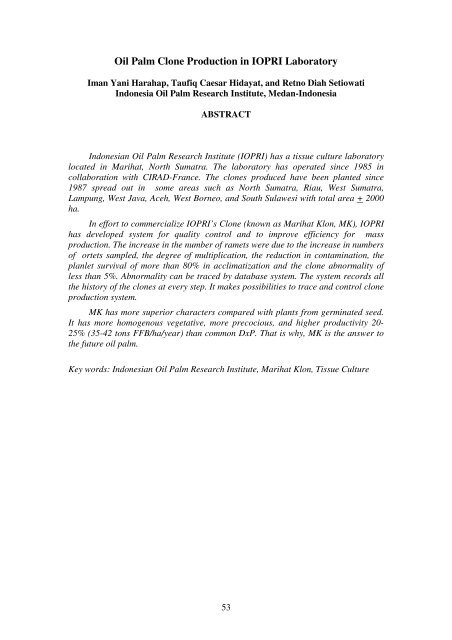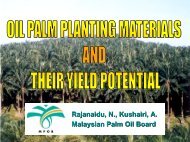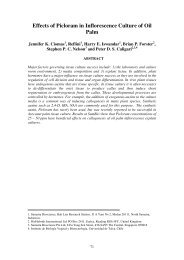Oil Palm Clone Production in IOPRI Laboratory - isopb
Oil Palm Clone Production in IOPRI Laboratory - isopb
Oil Palm Clone Production in IOPRI Laboratory - isopb
Create successful ePaper yourself
Turn your PDF publications into a flip-book with our unique Google optimized e-Paper software.
<strong>Oil</strong> <strong>Palm</strong> <strong>Clone</strong> <strong>Production</strong> <strong>in</strong> <strong>IOPRI</strong> <strong>Laboratory</strong><br />
Iman Yani Harahap, Taufiq Caesar Hidayat, and Retno Diah Setiowati<br />
Indonesia <strong>Oil</strong> <strong>Palm</strong> Research Institute, Medan-Indonesia<br />
ABSTRACT<br />
Indonesian <strong>Oil</strong> <strong>Palm</strong> Research Institute (<strong>IOPRI</strong>) has a tissue culture laboratory<br />
located <strong>in</strong> Marihat, North Sumatra. The laboratory has operated s<strong>in</strong>ce 1985 <strong>in</strong><br />
collaboration with CIRAD-France. The clones produced have been planted s<strong>in</strong>ce<br />
1987 spread out <strong>in</strong> some areas such as North Sumatra, Riau, West Sumatra,<br />
Lampung, West Java, Aceh, West Borneo, and South Sulawesi with total area + 2000<br />
ha.<br />
In effort to commercialize <strong>IOPRI</strong>’s <strong>Clone</strong> (known as Marihat Klon, MK), <strong>IOPRI</strong><br />
has developed system for quality control and to improve efficiency for mass<br />
production. The <strong>in</strong>crease <strong>in</strong> the number of ramets were due to the <strong>in</strong>crease <strong>in</strong> numbers<br />
of ortets sampled, the degree of multiplication, the reduction <strong>in</strong> contam<strong>in</strong>ation, the<br />
planlet survival of more than 80% <strong>in</strong> acclimatization and the clone abnormality of<br />
less than 5%. Abnormality can be traced by database system. The system records all<br />
the history of the clones at every step. It makes possibilities to trace and control clone<br />
production system.<br />
MK has more superior characters compared with plants from germ<strong>in</strong>ated seed.<br />
It has more homogenous vegetative, more precocious, and higher productivity 20-<br />
25% (35-42 tons FFB/ha/year) than common DxP. That is why, MK is the answer to<br />
the future oil palm.<br />
Key words: Indonesian <strong>Oil</strong> <strong>Palm</strong> Research Institute, Marihat Klon, Tissue Culture<br />
53
INTRODUCTION<br />
Indonesian <strong>Oil</strong> <strong>Palm</strong> Research Institute (<strong>IOPRI</strong>) has a tissue culture laboratory<br />
located <strong>in</strong> Marihat, North Sumatra. The laboratory has operated s<strong>in</strong>ce 1985 <strong>in</strong><br />
collaboration with CIRAD-French. The clones produced have been planted s<strong>in</strong>ce<br />
1987, spread out <strong>in</strong> some areas <strong>in</strong> Indonesia such as North Sumatra, Riau, West<br />
Sumatra, Lampung, West Java, Aceh, West Borneo, and South Sulawesi with total<br />
area + 2000 ha.<br />
When clones were produced by tissue culture that was true to type with their<br />
ortet, they would have productivity 20-25% higher than DxP. But <strong>in</strong> this<br />
development, clones had problems with mantled fruit (abnormality). For this reason,<br />
s<strong>in</strong>ce 1995 <strong>IOPRI</strong> conducted research and evaluations of the clone performance <strong>in</strong> the<br />
field. Now it has found strategy to prevent the abnormality. Commercial clones that<br />
are produced by <strong>IOPRI</strong> come from material that has been selected by tight criteria.<br />
The latest technology can produce superior oil palm with a short immature period,<br />
homogenous plan growth, and productivity of FFB and oil 20-25% higher than the<br />
material from seeds (DxP).<br />
OIL PALM CLONE PRODUCTION IN <strong>IOPRI</strong>’S LABORATORY<br />
<strong>IOPRI</strong> tissue culture laboratory has been operat<strong>in</strong>g s<strong>in</strong>ce 1985, but problems <strong>in</strong><br />
abnormality made it advance slowly. For this reason research and evaluation were<br />
conducted to solve the problem. In early 2007, a new resolution were implemented <strong>in</strong><br />
<strong>IOPRI</strong> tissue culture techniques <strong>in</strong> order to produce a true superior clone. System<br />
process and selection were controlled to m<strong>in</strong>imize abnormality, limit contam<strong>in</strong>ation<br />
and <strong>in</strong>crease efficiency. Database was developed to record all the process so that all<br />
the plants planted <strong>in</strong> the field could have their history traced.<br />
Tissue culture has specific steps to produce clones. <strong>Oil</strong> palm explants are<br />
taken from young leaves. Explants are <strong>in</strong>duced to <strong>in</strong>to callogenesis, embryogenesis,<br />
shootlet, root <strong>in</strong>duction, and f<strong>in</strong>ally planlet. It takes 12-16 months from explants to<br />
become planlets. Not all ortets can produce planlets. Some produce very well calli <strong>in</strong><br />
short time, but some do not. Explants without produc<strong>in</strong>g calli will be swept out after 2<br />
years. So far, multiplication <strong>in</strong>dex <strong>in</strong> <strong>IOPRI</strong> tissue culture laboratory varies <strong>in</strong> every<br />
step. The lowest is calli <strong>in</strong>duction from explants; its multiplication <strong>in</strong>dex is 0.03 or 3%<br />
54
from explants. The highest multiplication <strong>in</strong>dex is embryogenesis; it is 24 or 2400%<br />
are showed <strong>in</strong> Table 1.<br />
With a tight limitation <strong>in</strong> number of subcultures (it is limited to only 12<br />
subcultures totally along the process, less then 2 years <strong>in</strong> the process from calli to<br />
plantlets), <strong>IOPRI</strong> can produce about 86,000 planlets from an ortet. Then planlets will<br />
be acclimated before they are sent to the nursery.<br />
Tabel 1. Multiplication Index of Marihat Klon <strong>in</strong> <strong>IOPRI</strong> Tissue Culture <strong>Laboratory</strong><br />
No Phase<br />
Process<br />
From To<br />
Quantity<br />
From To<br />
Multiplication<br />
(%)<br />
1 Explant Explant Pre-Callus 2000 60 3<br />
2 Callogenesis Pre-Callus Callus 60 500 840<br />
3 Embryogenesis Callus Embryo 500 12,000 2,400<br />
4 Pre Shoot Embryo Pre-Shoot 12,000 203,000 1,700<br />
5 Shoot Pre-Shoot Shoot 203,000 119,000 58<br />
6 Root <strong>in</strong>ducsion I Shoot R.Induction I 119,000 107,000 90<br />
7 Root <strong>in</strong>ducsion I R.Induction I R.Induction II 107,000 96,000 90<br />
8 Planlet R.Induction II Planlet 96,000 86,000 90<br />
Vegetative Performance<br />
THE LATEST MARIHAT KLON PERFORMANCE<br />
Field observation showed that MK can adapt well with the environment. Table<br />
2 shows that Leaf Area Index (LAI) of 3 plants from MK is higher than common<br />
DxP. It means that MK performance is better aga<strong>in</strong>st common DxP.<br />
Tabel 2. Marihat klone vegetative performance at 3 years old <strong>in</strong> Afd. I Marihat Estate PTPN.<br />
IV.<br />
High Number Long of Petiola Sum Average<br />
Plant of Rachis (cm) Lam<strong>in</strong>a Lam<strong>in</strong>a<br />
Blok (cm) Frond Long Thickness 1 side Long Thickness LAI<br />
D X P<br />
MK-558<br />
MK-610<br />
MK-629<br />
164.70 43 363.80 5.06 3.18 130 0.88 0.04<br />
175.80 55 342.90 4.92 2.70 117 0.78 0.05<br />
191.50 50 432.10 5.61 3.85 134 0.95 0.05<br />
166.00 49 355.90 5.02 2.95 129 0.90 0.04<br />
55<br />
3.2<br />
3.6<br />
4.2<br />
3.6
Generative Performance<br />
Flower<strong>in</strong>g census of the clones which were planted <strong>in</strong> Afdel<strong>in</strong>g I Marihat Estate<br />
PTPN IV North Sumatra showed that at the age of 16 months 90% had flowered.<br />
From the total 1.542 plants, there were 1,451 plants normal (82.20%), 60 plants with<br />
heavy mantled fruit (15.87%), and 31 plants with light mantled fruit (1.93%). It was<br />
observed from one location and it needed more locations to compare. G<strong>in</strong>t<strong>in</strong>g (1995)<br />
said that light mantled fruit can turn <strong>in</strong>to normal plant with the maturity of the plant<br />
after 4-5 years. But heavy mantled would not become normal (Table 3).<br />
Tabel 3. Flower performance of marihat klon (MK) <strong>in</strong> Afdel<strong>in</strong>g I kebun Marihat PTPN IV<br />
North Sumatera at 3 years<br />
No MK Cross<strong>in</strong>g Total Normal<br />
Number of Fruits<br />
Heavy mantled Light Mantled<br />
number percent number percent number percent<br />
1 610<br />
RS 084 D X<br />
MA 840 T<br />
1001 959 95.80 18 1.80 24 2.40<br />
2 629<br />
DS 029 D X<br />
LM 002 T<br />
295 283 95.93 9 3.05 3 1.02<br />
3 558<br />
BO 516 D X<br />
BO 443 P<br />
135 131 97.04 2 1.48 2 1.48<br />
4 622<br />
LM 274 D X<br />
LM 2399T<br />
31 21 67.74 10 32.26 0 -<br />
5 634<br />
DS 029 D X<br />
LM 002 T<br />
27 19 70.37 8 29.63 0 -<br />
6 614<br />
BO 126 D X<br />
LM 002 T<br />
30 25 83.33 5 16.67 0 -<br />
7 638<br />
DS 029 D X<br />
LM 002 T<br />
19 9 47.37 8 42.11 2 10.53<br />
8 637<br />
DS 029 D X<br />
LM 002 T<br />
4 4 100.00 0 - 0 -<br />
Jumlah 1542 1451 82.20 60 15.87 31 1.93<br />
It can not present productivity of MK <strong>in</strong> Afd. I Kebun Marihat PTPN.IV<br />
because it is still immature phase, but trosen tell<strong>in</strong>g that conducted when the plants<br />
were 3 years showed that total number flowers of MK was 22.38 % higher than plants<br />
from germ<strong>in</strong>ated seeds. Number of bunches of MK is also 22.38 % higher than<br />
common DxP. G<strong>in</strong>t<strong>in</strong>g (2007) reported that MK productivity was higher than<br />
common DxP. There was a lilttle differrence with G<strong>in</strong>t<strong>in</strong>g (2007), observation result<br />
found that Mk productivity was 37% higher than common DxP at the first production<br />
age.<br />
56
Table4. Comparison of MK and DxP Flower Performance <strong>in</strong> Afd. I kebun Marihat PTPN.IV<br />
at 3 years old<br />
No MK Hybrid Trial<br />
Total<br />
Floresence<br />
Bunch<br />
Percentage<br />
Antera<br />
Percentage<br />
Sum (%) Sum (%)<br />
1 610<br />
RS 084 D X MA<br />
840 T<br />
DS 029 D X LM<br />
10.72 9.34 87.13 1.38 12.87<br />
2 629 002 T<br />
BO 516 D X BO<br />
10.98 9.6 87.43 1.38 12.57<br />
3 558 443 P 10.8 8.8 81.48 2 18.52<br />
Average 10.83 9.25 85.35 1.59 14.65<br />
4 DXP 7.7 6.7 87.01 1 12.99<br />
Average<br />
7.70<br />
CONCLUSION<br />
57<br />
6.70 87.01<br />
1.00 12.99<br />
Indonesian <strong>Oil</strong> <strong>Palm</strong> Research Institute (<strong>IOPRI</strong>) has conducted tissue culture<br />
research s<strong>in</strong>ce 1985 <strong>in</strong> collaboration with CIRAD-French with capacity of 1,000,000<br />
plantlets a year. Today, besides research, <strong>IOPRI</strong> also produces oil palm clones<br />
(known as Marihat Klon, MK) for commercial scale. Multiplication <strong>in</strong>dex of an ortet<br />
is 86,000 plantlets. The ma<strong>in</strong> problem <strong>in</strong> tissue culture, abnormal plant (mantled<br />
fruit), has been m<strong>in</strong>imized by limitation of subculture numbers, limited culture<br />
storage to less than 2 years, and m<strong>in</strong>imiz<strong>in</strong>g hormone usage. <strong>IOPRI</strong> also conducts<br />
clone field trials before releas<strong>in</strong>g commercial MK. Abnormality can be traced by a<br />
database system. The system records all the history of the clone at every step. It<br />
makes it possible to trace and control clone production system.
REFERENCE<br />
Corley, R.H.V., C.H.Lee, I.H.Law and C.Y.Wong (1986). Abnormal flower<br />
development <strong>in</strong> oil palm clones. The Planter, 62, 233-240. 69<br />
Duran-Gassel<strong>in</strong>, T, Y. Duval, L.Baudou<strong>in</strong>, A.B. Maheran, K.Konan & J.M.Noire<br />
(1993). Description and degree of the mantled flower<strong>in</strong>g abnormality <strong>in</strong> oil<br />
palm (Elaeis qu<strong>in</strong>eensis Jacq) clones produced us<strong>in</strong>g the Orstam-CIRAD<br />
Procedure. In Proc. of the 1993 ISOPB Int. Symp. Recent Development <strong>in</strong> <strong>Oil</strong><br />
<strong>Palm</strong> Tissue Culture and Biotechnology. Kuala Lumpur, 14-15 September,<br />
1993, p.48-63.<br />
Fatmawati, Gale, G., and Sjafrul, L., 1998. The improvement of survival rate of oil<br />
palm planlet at pre-nursery through <strong>in</strong>-vitro harden<strong>in</strong>g, <strong>Oil</strong> <strong>Palm</strong> Research<br />
Journal vol 6 no.3 p.177-190. PPKS Press, Medan.<br />
G<strong>in</strong>t<strong>in</strong>g, G., Christian, M., and Kabul, P., 1996. Embriogenesis somatic pada kelapa<br />
sawit untuk perbanyakan secara <strong>in</strong>-vitro klon unggul, Jurnal Penelitian Kelapa<br />
Sawit, vol 4 no.1 p.1-16, PPKS Press, Medan.<br />
______, Subronto, Tri, H., Fatmawati, and Adl<strong>in</strong>, U.L., 1995. Penampilan awal klon<br />
kelapa sawit yang dihasilkan oleh PPKS, Jurnal Penelitian Kelapa Sawit, vol 3<br />
no.1 p.11-26. PPKS Press, Medan.<br />
______, and Diana, L.G., 2007. Increas<strong>in</strong>g oil palm production througt klon material,<br />
<strong>Oil</strong> <strong>Palm</strong> Research Journal vol 15 no.1 p.11-20. PPKS Press, Medan.<br />
Ikwan, M. and Dwi, A., 1998. Selection of ortet sources on dura x pisifera population<br />
for clonal propagation, <strong>Oil</strong> <strong>Palm</strong> Research Journal vol 6 no.3 p.165-176. PPKS<br />
Press, Medan.<br />
Nurhaimi– Haris and A. Darussam<strong>in</strong> (1997). RAPD analysis of oil palm clones with<br />
normal and abnormal fruits. Menara Perkebunan, 65, (2), 64-74.<br />
Slater, A., Nigel, W.S., and Mark, R.F., 2008. Plant Biotechnology ‘the genetic<br />
manipulation of plants’, second edition, Oxford University Press, New York.<br />
Subronto, Gale, G., and Fatmawati, 1997. The effect of growth media and relative<br />
humidity on growth of planlet <strong>in</strong> pre-nursery, <strong>Oil</strong> <strong>Palm</strong> Research Journal vol 5<br />
no.1 p.1-10. PPKS Press, Medan.<br />
Toruan-Matius, N., Saro, I.B., and B<strong>in</strong>tang, M., 2001. Analysis abnormalities of oil<br />
palm (Elaeis gu<strong>in</strong>eensis Jacq) from tissue culture by random amplified<br />
polymorphic DNA (RAPD), Menara Perkebunan 69 (2), p.58-70.<br />
58




